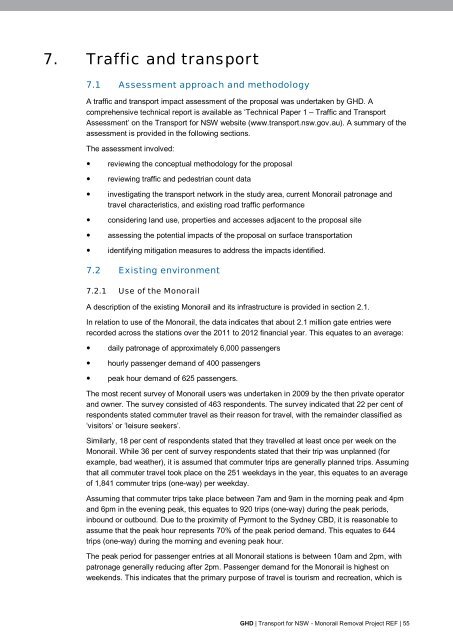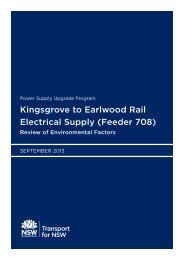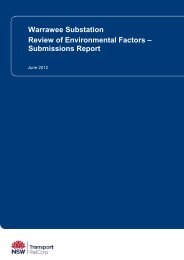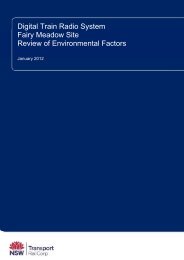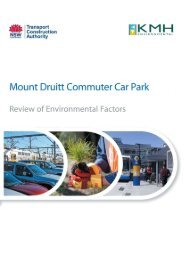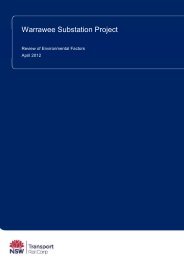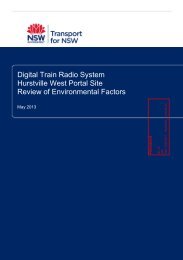Monorail Removal Project - Review of Environmental Factors (REF)
Monorail Removal Project - Review of Environmental Factors (REF)
Monorail Removal Project - Review of Environmental Factors (REF)
You also want an ePaper? Increase the reach of your titles
YUMPU automatically turns print PDFs into web optimized ePapers that Google loves.
7. Traffic and transport7.1 Assessment approach and methodologyA traffic and transport impact assessment <strong>of</strong> the proposal was undertaken by GHD. Acomprehensive technical report is available as ‘Technical Paper 1 – Traffic and TransportAssessment’ on the Transport for NSW website (www.transport.nsw.gov.au). A summary <strong>of</strong> theassessment is provided in the following sections.The assessment involved:• reviewing the conceptual methodology for the proposal• reviewing traffic and pedestrian count data• investigating the transport network in the study area, current <strong>Monorail</strong> patronage andtravel characteristics, and existing road traffic performance• considering land use, properties and accesses adjacent to the proposal site• assessing the potential impacts <strong>of</strong> the proposal on surface transportation• identifying mitigation measures to address the impacts identified.7.2 Existing environment7.2.1 Use <strong>of</strong> the <strong>Monorail</strong>A description <strong>of</strong> the existing <strong>Monorail</strong> and its infrastructure is provided in section 2.1.In relation to use <strong>of</strong> the <strong>Monorail</strong>, the data indicates that about 2.1 million gate entries wererecorded across the stations over the 2011 to 2012 financial year. This equates to an average:• daily patronage <strong>of</strong> approximately 6,000 passengers• hourly passenger demand <strong>of</strong> 400 passengers• peak hour demand <strong>of</strong> 625 passengers.The most recent survey <strong>of</strong> <strong>Monorail</strong> users was undertaken in 2009 by the then private operatorand owner. The survey consisted <strong>of</strong> 463 respondents. The survey indicated that 22 per cent <strong>of</strong>respondents stated commuter travel as their reason for travel, with the remainder classified as‘visitors’ or ‘leisure seekers’.Similarly, 18 per cent <strong>of</strong> respondents stated that they travelled at least once per week on the<strong>Monorail</strong>. While 36 per cent <strong>of</strong> survey respondents stated that their trip was unplanned (forexample, bad weather), it is assumed that commuter trips are generally planned trips. Assumingthat all commuter travel took place on the 251 weekdays in the year, this equates to an average<strong>of</strong> 1,841 commuter trips (one-way) per weekday.Assuming that commuter trips take place between 7am and 9am in the morning peak and 4pmand 6pm in the evening peak, this equates to 920 trips (one-way) during the peak periods,inbound or outbound. Due to the proximity <strong>of</strong> Pyrmont to the Sydney CBD, it is reasonable toassume that the peak hour represents 70% <strong>of</strong> the peak period demand. This equates to 644trips (one-way) during the morning and evening peak hour.The peak period for passenger entries at all <strong>Monorail</strong> stations is between 10am and 2pm, withpatronage generally reducing after 2pm. Passenger demand for the <strong>Monorail</strong> is highest onweekends. This indicates that the primary purpose <strong>of</strong> travel is tourism and recreation, which isGHD | Transport for NSW - <strong>Monorail</strong> <strong>Removal</strong> <strong>Project</strong> <strong>REF</strong> | 55


